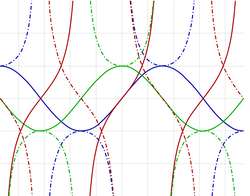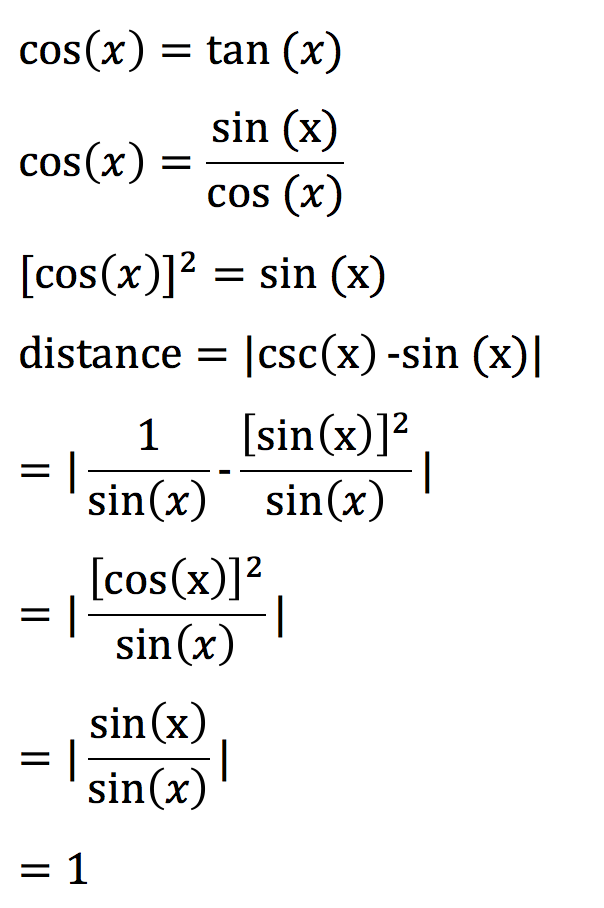Graphometry
 ⎩
⎪
⎪
⎪
⎪
⎪
⎨
⎪
⎪
⎪
⎪
⎪
⎧
y
=
sin
(
x
)
y
=
cos
(
x
)
y
=
tan
(
x
)
y
=
csc
(
x
)
⎩
⎪
⎪
⎪
⎪
⎪
⎨
⎪
⎪
⎪
⎪
⎪
⎧
y
=
sin
(
x
)
y
=
cos
(
x
)
y
=
tan
(
x
)
y
=
csc
(
x
)
The four graphs above are drawn on the same axes from x = 0 to x = 2 π .
If a vertical line is drawn where the graphs of y = cos ( x ) and y = tan ( x ) intersect, this line intersects the graphs of y = sin ( x ) and y = csc ( x ) at points A and B . What is the distance between A and B ?
The answer is 1.
This section requires Javascript.
You are seeing this because something didn't load right. We suggest you, (a) try
refreshing the page, (b) enabling javascript if it is disabled on your browser and,
finally, (c)
loading the
non-javascript version of this page
. We're sorry about the hassle.
3 solutions

why did you take the distance as cosec(x)-sin(x)
Log in to reply
I think the distance is |csc(x) -sin(x)| since the x values from both graph is the same since the distance can be calculated by sqrt((y1-y2)^2)
Sorry for the big font, I insert an image from ms word and suddenly it become big
When y = cos x meets y = tan x
⇒ cos x cos x cos 2 x 1 − sin 2 x sin 2 x + sin x − 1 ⇒ sin x = tan x = cos x sin x = sin x = sin x = 0 = 2 − 1 ± 5 = 2 5 − 1 for x ∈ [ 0 , 2 π ]
For x = sin − 1 ( 2 5 − 1 )
⇒ A = sin x = 2 5 − 1 ⇒ B = csc x = sin x 1 = 5 − 1 2
The distance between A and B ,
∣ A − B ∣ = ∣ ∣ ∣ ∣ ∣ 2 5 − 1 − 5 − 1 2 ∣ ∣ ∣ ∣ ∣ = ∣ ∣ ∣ ∣ ∣ 2 5 − 1 − 4 2 ( 5 + 1 ) ∣ ∣ ∣ ∣ ∣ = ∣ ∣ ∣ ∣ ∣ 2 5 − 1 − 5 − 1 ∣ ∣ ∣ ∣ ∣ = ∣ ∣ ∣ ∣ 2 − 2 ∣ ∣ ∣ ∣ = 1
Moderator note:
Is there another approach in which we do not need to explicitly evaluate sin x ?
Hint: For the given value of x , what is sin 2 x − 1 equal to?
Why is the x = sin^-1(( root5 -1)/2) part needed?
Log in to reply
Because x has two values 2 5 − 1 and 2 − 5 − 1 and I was referring the former value.
0 <= x <= pi/2
cos(x) = tan(x)
cos(x)^2 = sin(x)
1 - sin(x)^2 = sin(x)
sin(x)^2 + sin(x) - 1 = 0
-1 <= sin(x) <= 1
sin(x) = (-1 +- sqrt(5))/2
sin(x) =(-1 - sqrt(5))/2 < -1 not accepted
sin(x) =(-1 + sqrt(5))/2
csc(x) = 1/sin(x)
|sin(x) - 1/sin(x)| = |(-1 + sqrt(5))/2 - 2/(-1 + sqrt(5))| = 1